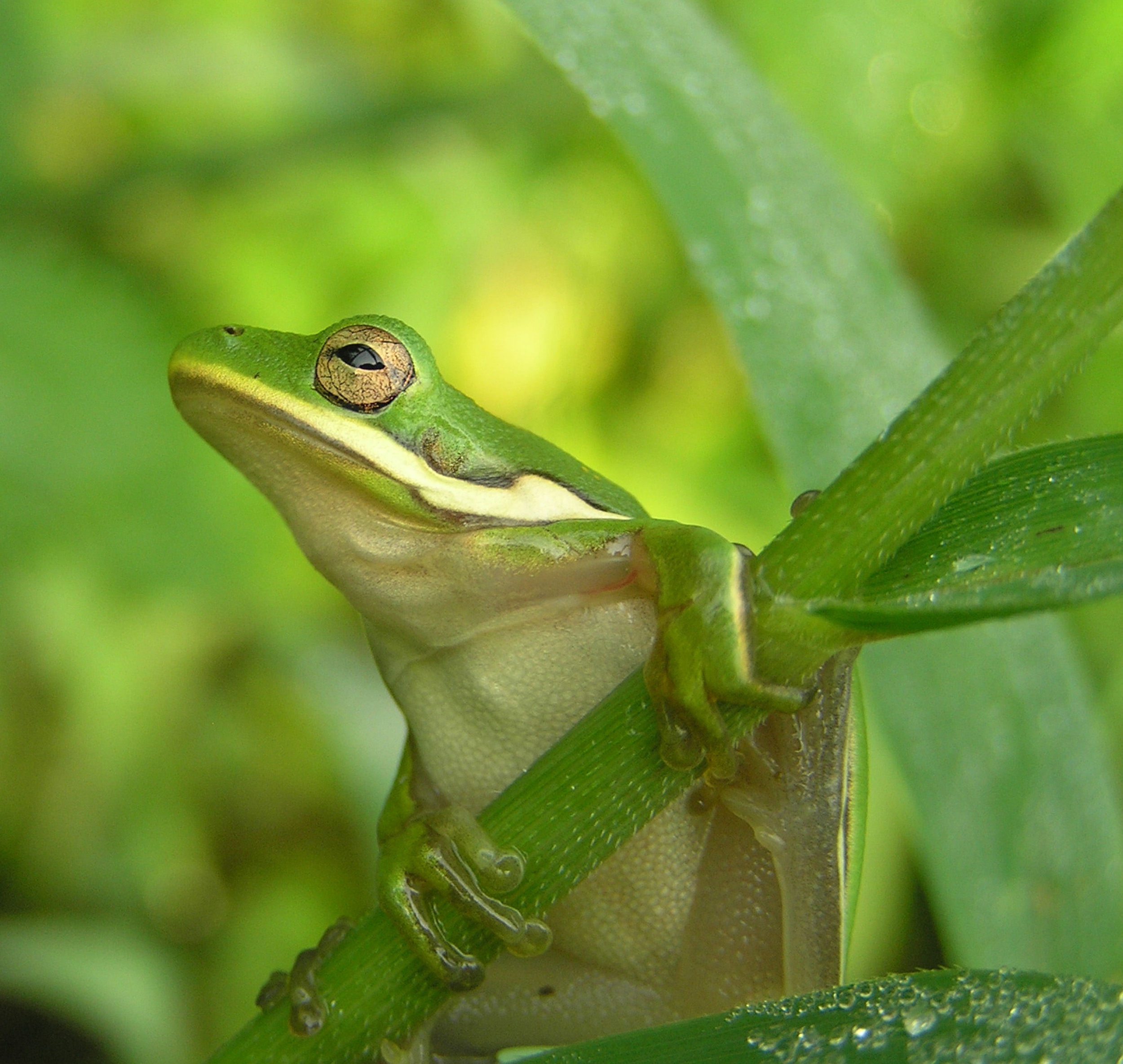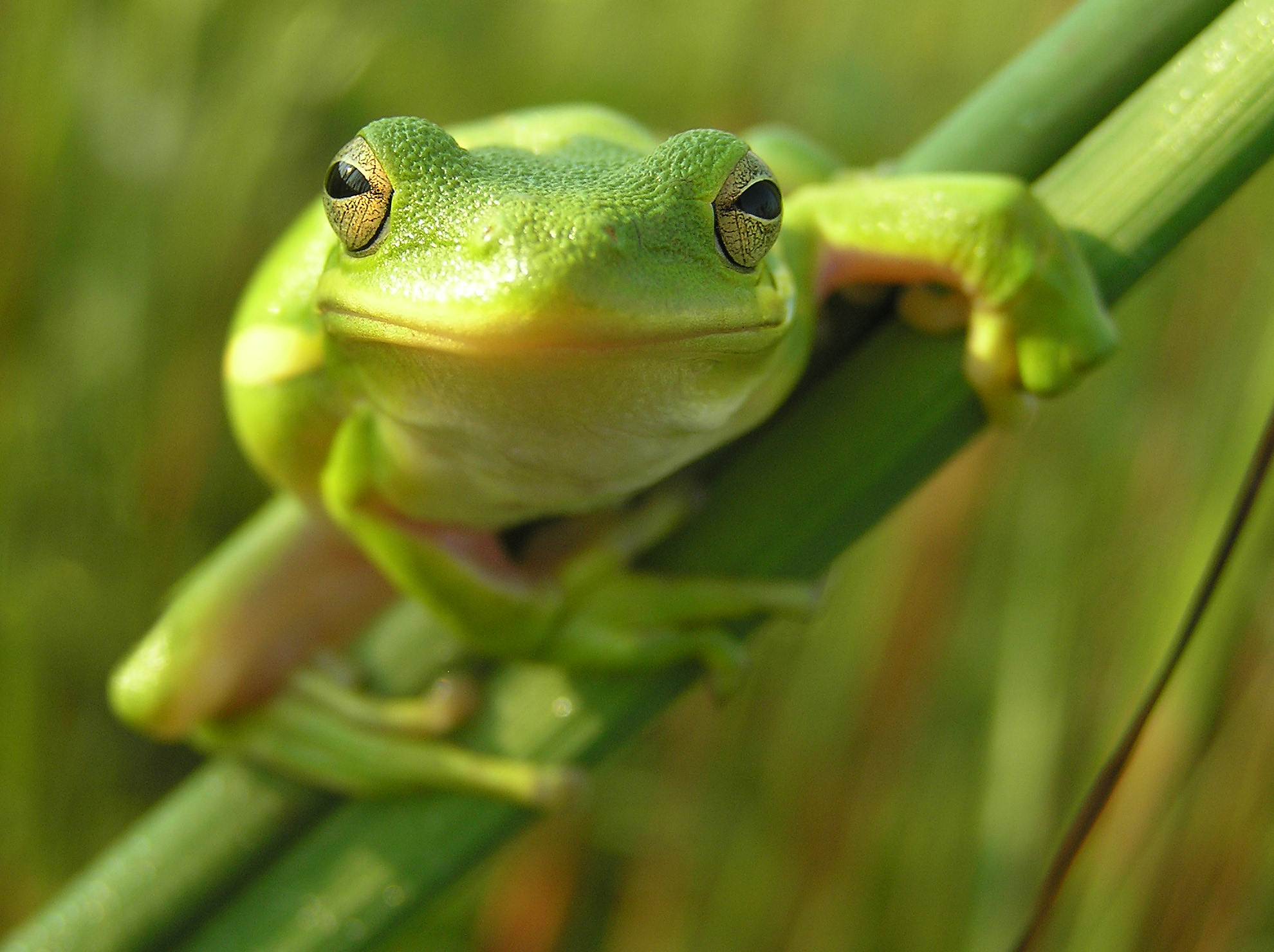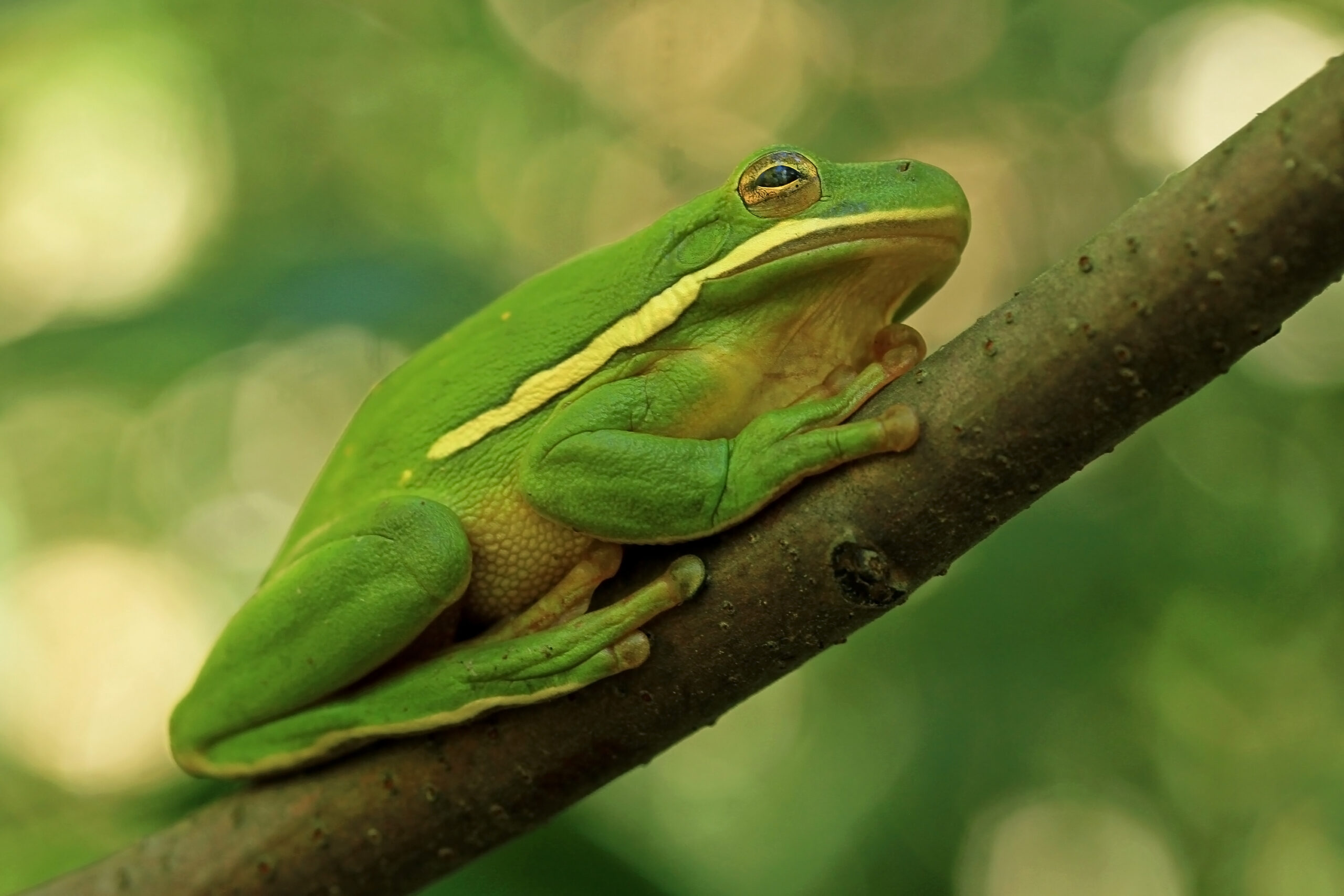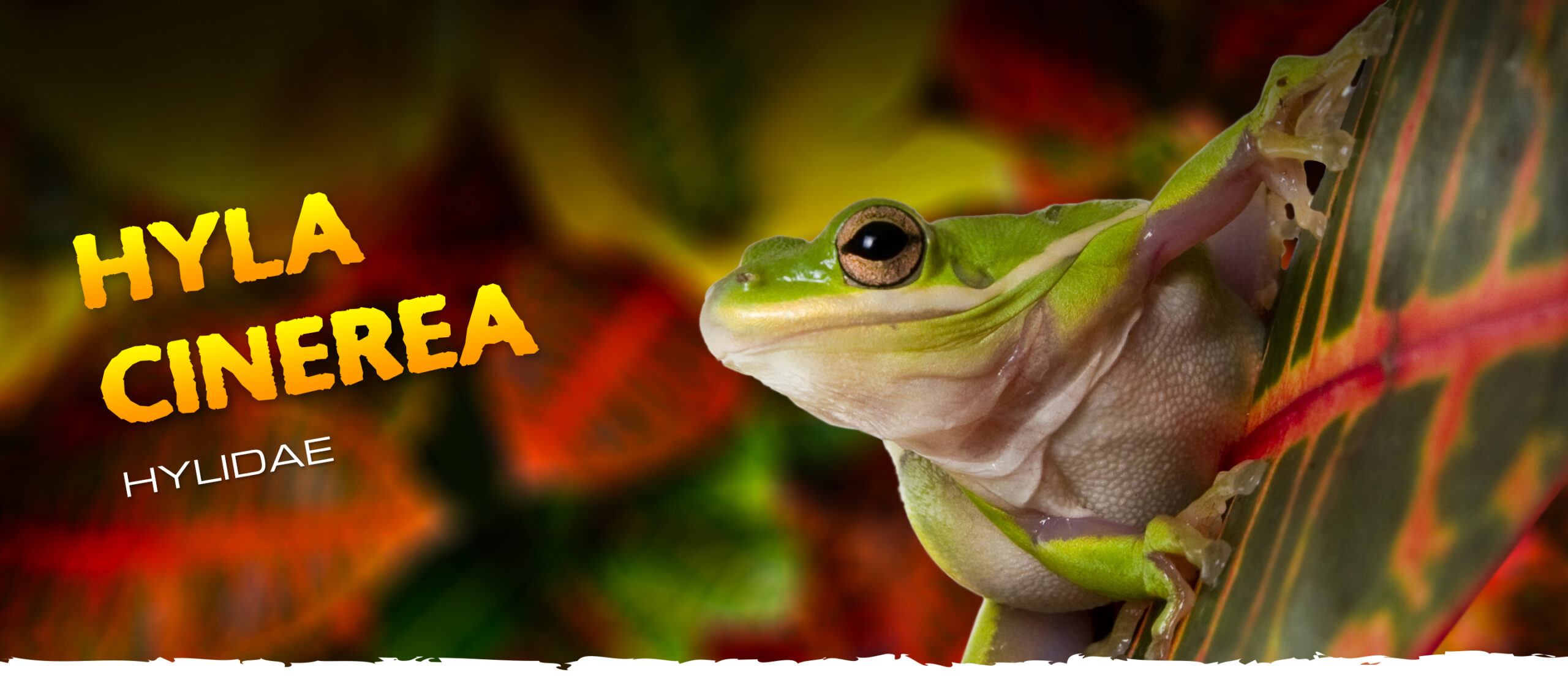
Hyla cinerea
LATIN NAME
FAMILY
ADULT SIZE
LIFESPAN
RANGE
HABITAT
TEMPERATURE
HUMIDITY
UVB CHART
SKILL LEVEL
LATIN NAME
FAMILY
ADULT SIZE
LIFESPAN
RANGE
HABITAT
TEMPERATURE
HUMIDITY
UVB CHART
SKILL LEVEL
American Green Tree Frogs are native to the Southeastern United States roughly from Eastern Virginia to Florida in the East and from Central Texas all the way to the West. There’s also records of introduced populations in Puerto Rico and even some invasive American Green Tree Frogs have been noticed in Hawaii.
They can be primarily found around lakes, ponds, swamps, streams and in wetlands. They prefer habitats with floating vegetation, reeds & grasses, and shrubs with branches overgrowing the riparian zone. American Green Tree Frogs easily adapt to various habitats and can be found in urban environments, like garden ponds in private gardens, hotel gardens and industrial complexes.
American Green Tree Frogs are hardy, long-lived and “easy-to-care-for” amphibians. Their engaging personalities, their bright yellow-green back and cream-white lateral stripe running from just under their big golden eyes all the way to their groin, make them appealing display animals for both the beginning reptile enthusiast as well as for the advanced hobbyist.
American Green Tree Frogs are a fairly social species and are best enjoyed when kept in small groups of 4 to 8 animals. The interaction between the animals in these small groups increases the viewing pleasure but also stimulates their mating behavior.
The American Green Tree Frog has been successfully bred in Europe and the USA for decades. American Green Tree Frogs are available as wild-caught specimen as well as captive-bred. We do recommend starting with captive-bred specimen, so you know their age and can rest assured that the youngsters are healthy.
The American Green Tree Frog was first scientifically classified by the German naturalist Johann Gottlob Schneider in his Historia Amphibiorum Naturalis et Literarariae, published in 1799, as Calamita cinereus. In 1890, Garman renamed the American Green Tree Frog to Hyla cinerea. In 2016 Duellman, Marion, and Hedges (Zootaxa, 4104 2016) changed the name from Hyla cinerea to Dryophytes cinereus, but since this description is not widely accepted, for the time being, we will keep referring to the American Green Tree Frog as Hyla cinerea (Subgenus: Dryophytes).American Green Tree Frogs are amphibians, a word that derives from the Ancient Greek word “amphibios”, meaning “to live a double life”, one as a tadpole in water, one as a frog on land.
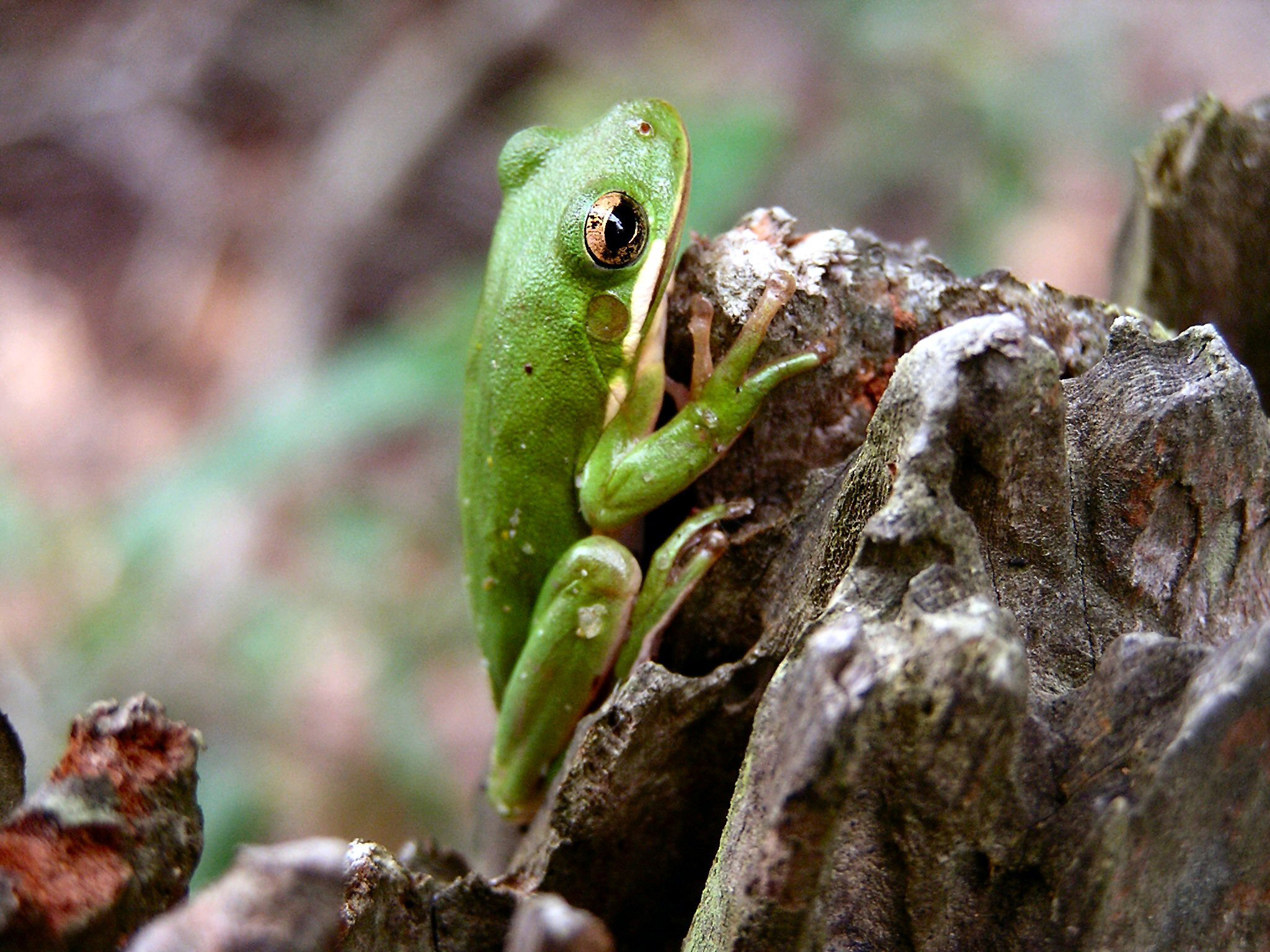
Hyla cinerea resting on rock outcrop - by A. Carneal.
American Green Tree Frogs belong to the family Hylidae (subfamily Hylinae) in the Subgenus Dryophytes.
American Green Tree Frogs have a beautiful, bright yellow-green back with a light cream-white lateral stripe running from just under their big golden eyes all the way to their groin. As most tree frogs, American Green Tree Frogs are also capable of adjusting their color shade from a light green to an olive green, to even a light brownish shade. Their belly consists of a creamy-white base with a somewhat rough texture. Their golden eyes have a horizontal pupil, typical for members of the Hylinae subfamily.
While mating, American Green Tree Frogs perform an intimate embrace, called the amplexus. During the breeding season, males develop brown nuptial (mating) pads with a roughened surface on the first digit of their forelegs. These pads not only serve to improve the male’s grip on the female during amplexus, but glands below the surface of the nuptial pads also secrete pheromones (amplexins) that may influence the courtship duration. The males perform a mating call, that sounds like an old horn honking up to 75 times a minute, to attract the females.
Adult frogs range from 1.25 to 2.5″ or 3 to 6 cm in total length, males are typically smaller and slenderer than females. Once adult, the male frogs can be recognised by the loose skin on their throat, indicating their “vocal sac”.
If well fed & maintained, they can reach adult size and sexual maturity in 10-18 months and can live up to 7 years.
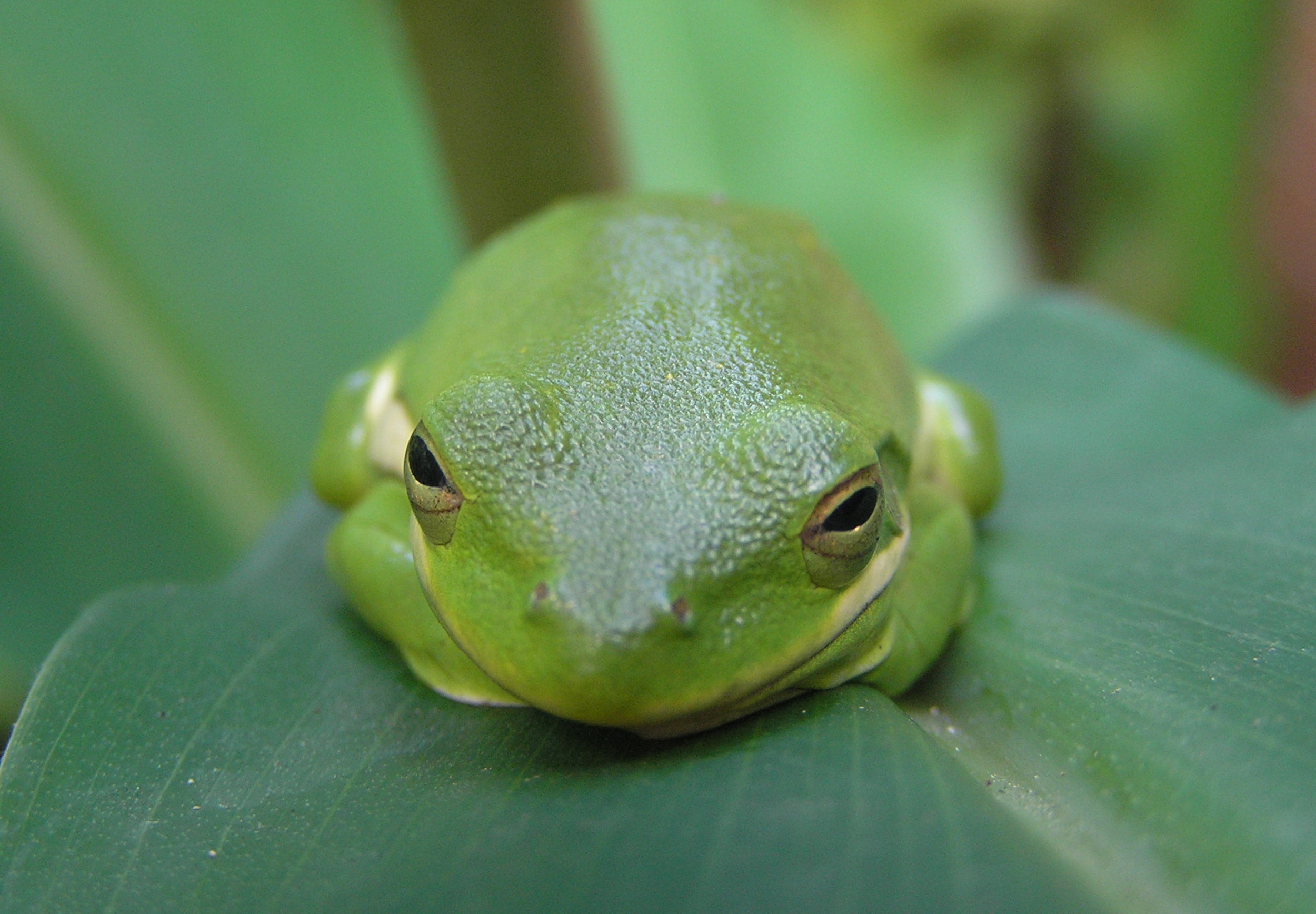
Hyla cinerea on leaf in sleeping position – by W. Parker.
American Green Tree Frogs are native to the Southeastern United States from Delaware and the entire Delmarva peninsula to southern and eastern Maryland, eastern Virginia, the Coastal Plains in the states of North Carolina, South Carolina, Georgia, Alabama, all of Florida including some of the Keys, the lower Mississippi Valley and surrounding states of Mississippi, Louisiana, eastern, south and central Arkansas, southeastern Missouri, southern Illinois, western Tennessee and Kentucky, eastern Texas, and portions of southeastern and extreme east-central Oklahoma. There’s also records of introduced populations in Puerto Rico and even some invasive American Green Tree Frogs have been noticed in Hawaii.
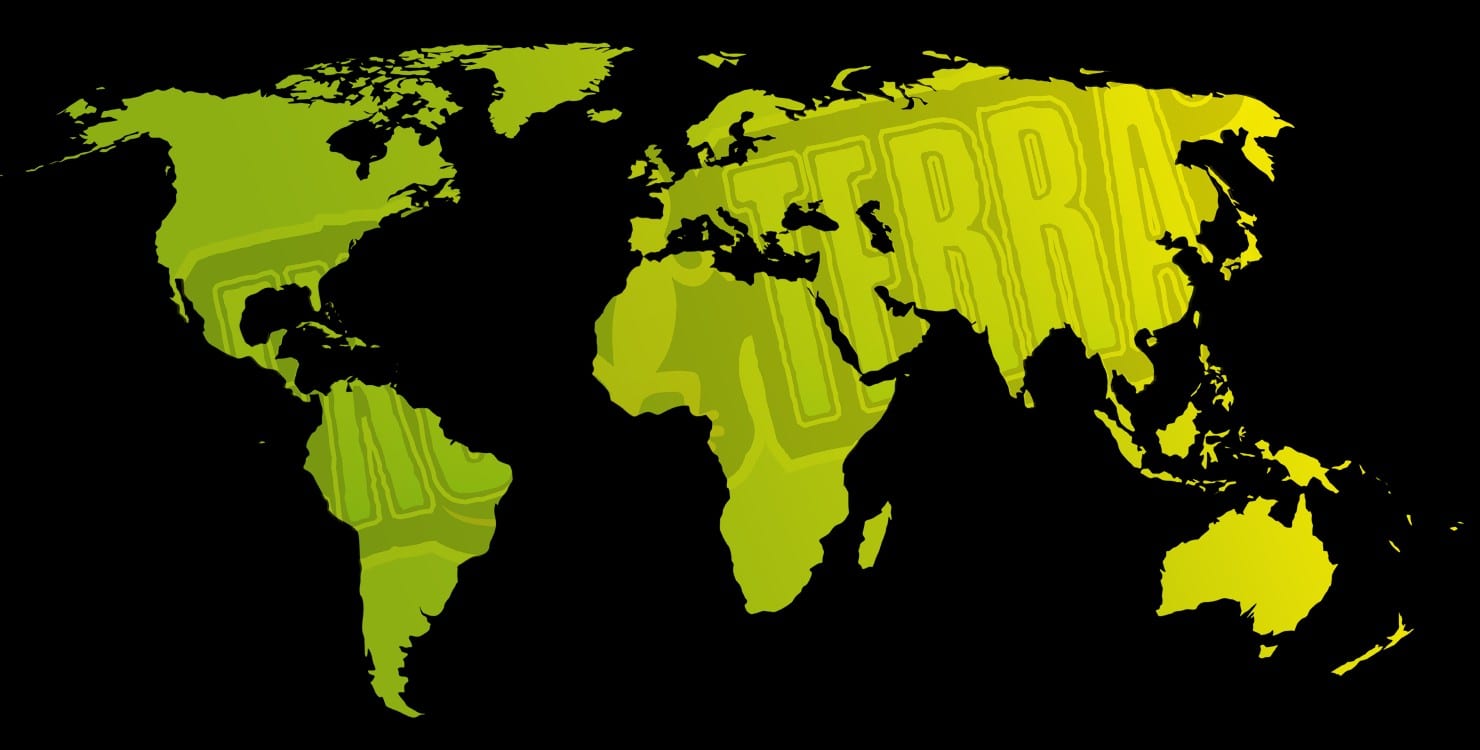
In the Wild
American Green Tree Frogs are arboreal and inhabit the riparian zones of lakes, ponds, swamps and streams and can also be found in wetlands. They prefer habitats with floating vegetation, reeds & grasses, and shrub borders with branches overgrowing the riparian zone. They also prefer an open, sunlit canopy rather than a thick sun-blocking one and avoid darker forests.
American Green Tree Frogs are both crepuscular and nocturnal, they sleep in the shrubs during daytime and start foraging the shrubs at night to feed on insects.
The mating of American Green Tree Frogs usually occurs during the somewhat warmer and more humid season, from April through August, following heavy rainfall. At nighttime during the breeding season, males continuously perform their mating call, that sounds like an old horn honking up to 75 times a minute, to attract the females.
The temperatures in the habitat of American Green Tree Frogs vary between the regions but also depend on the season.
The temperatures during the rainy season, from March through September-October fluctuate between 77-93°F or 25-34°C with humidity levels sometimes reaching +80%. Average temperatures in the somewhat drier colder months, from November through February, vary between 64-68°F or 18-20°C with a 55% low humidity. The average nighttime drop is around 18°F or 10°C during the winter months of December and January. Therefore, the nighttime temperatures can fall as low as 50°F or 10°C.
American Green Tree Frogs are both crepuscular and nocturnal but once acclimated, frogs will become active whenever their caretaker releases feeder insects in the terrarium.
American Green Tree Frogs are arboreal and prefer to live very near to a water body, a vertically oriented paludarium suits their lifestyle best. A paludarium is a semi-aquatic terrarium habitat that replicates a rainforest, swamp or stream and can harbour aquatic as well as terrestrial animal and plant species. The bottom part has an extra high front bottom glass, providing a higher water level and an increased water volume compared to common terrariums. This enables you to incorporate a substantial water part or aquarium section which allows you to keep aquatic animals and plants adjacent to the land or terrarium section. A part of the aquatic section can consist of a false bottom to support the land section, accommodate and hide the aquatic appliances like filters, pumps and water heaters and can double as a biological filtration media.
American Green Tree Frogs have a docile nature and can be kept individually or in small groups of 4-8 animals. The interaction between the animals in these small groups increases the viewing pleasure but also stimulates their mating behavior.
Terrarium
Exo Terra® Natural Terrariums are designed by European herpetologists and offer several housing options for American Green Tree Frogs. These glass terrariums feature front opening doors, allowing easy access for maintenance and feeding and a unique double ventilation system with full screen stainless steel top.
The Exo Terra® Natural Terrarium X-Tall (Paludarium) range allows you to create a semi-aquatic terrarium habitat that replicates a rainforest, swamp or stream and can harbour aquatic as well as terrestrial animal and plant species. The bottom part has an extra high front bottom glass, providing a higher water level and an increased water volume compared to common terrariums. A part of the aquatic section can consist of a false bottom to support the land section, accommodate and hide the aquatic appliances like filters, pumps and water heaters and can double as a biological filtration media.
The Exo Terra® Tree Frog Terrarium even comes with a built-in drain and tap valve which allows you to easily drain out excess spray water. This drain will come in handy when simulating the rainy season to induce mating behaviour in your frogs. The single front opening door allows maximum viewing pleasure and provides easy access for maintenance and feeding. A push-button lock keeps the terrarium secure and can even be outfitted with an optional lock to prevent unwanted opening. The hinged cover can be locked and unlocked with a single button and can be fully opened. A clear glass panel in the front ensures maximum visible light penetration and a stainless-steel ventilation strip in the back guarantees optimal ventilation. The patented dual ventilation system keeps the single front glass door free of condensation, even in humid conditions. It creates a natural upward flow of air to ensure optimal and healthy conditions. Excess heat is dissipated through the top mesh and prevents heat from accumulating, creating temperature gradients in the terrarium. The screen mesh allows UV and infrared penetration when these bulbs are required. Four self-closing inlets for wire/tubing in the back facilitate the installation of powered accessories like waterfall pumps, filters, the Exo Terra’s Monsoon, etc. The inside front of the lid has a Monsoon Nozzle mounting point on each side of the terrarium. The bottom part of the terrarium is waterproof once the tubing, elbow-connector and tap valve are connected to the drain. The drain allows hassle free water changes and excess water removal.
The Exo Terra® Frog Terrariums can be set up as a bioactive habitat for dart frogs, smaller tree & reed frogs, newts and salamanders, small geckoes & lizards, garter & grass snakes, etc.
Because of the American Green Tree Frog’s arboreal lifestyle and preference of living in the vicinity of water, the vertically oriented space and possibility to create a paludarium make the Tall and X-Tall Natural Terrariums the ideal enclosure for small groups of American Green Tree Frogs:
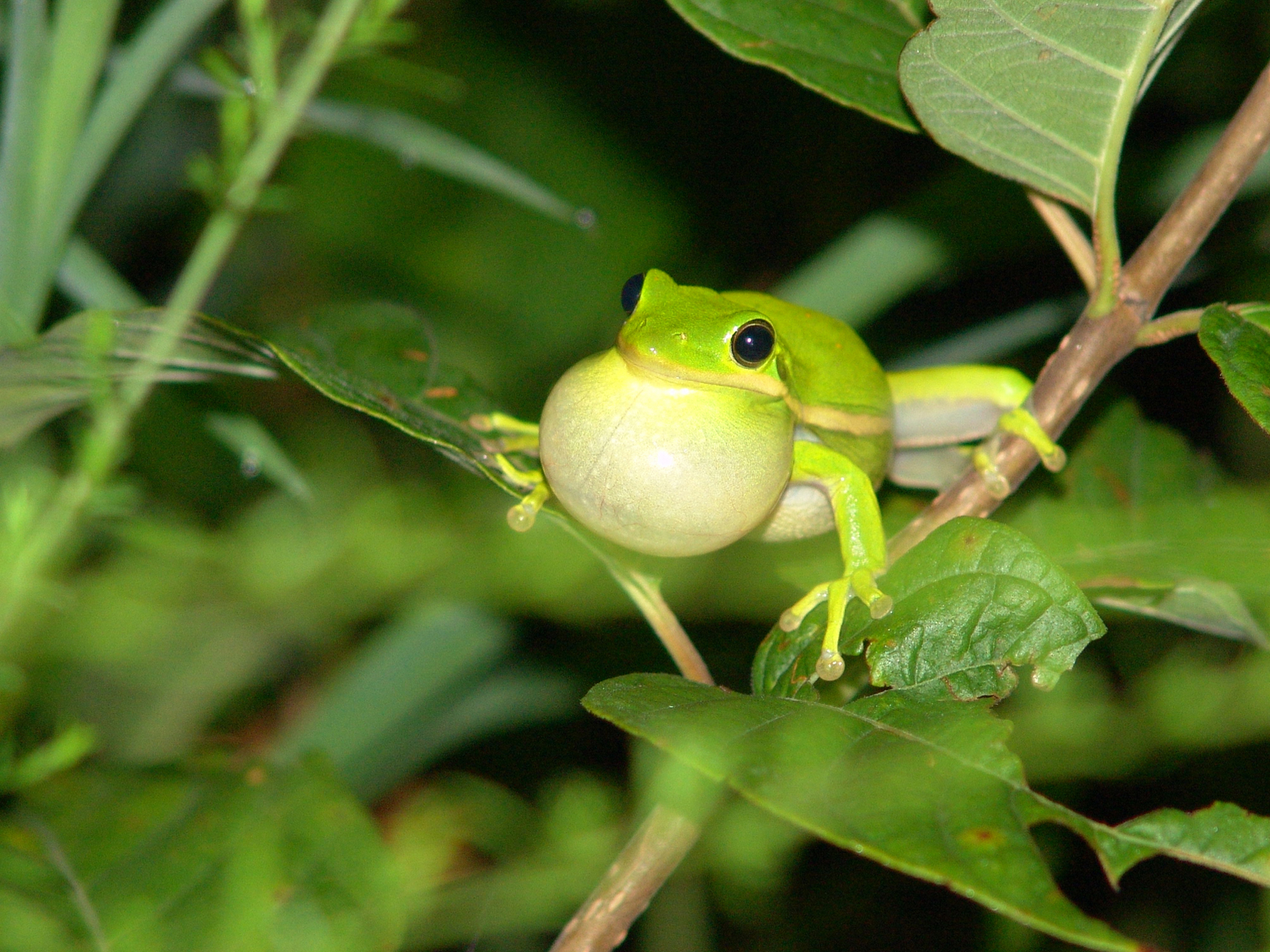
Hyla cinerea male calling at night– by T. Gamble.
Animals
PT2746 - Tree Frog Terrarium
PT2606 - Natural Terrarium – Small/X-Tall
PT2607 - Natural Terrarium – Small/Tall
PT2608 - Natural Terrarium – Medium/X-Tall
PT2609 - Natural Terrarium – Large/X-Tall
Dimensions
PT2746 - Tree Frog Terrarium
PT2606 - Natural Terrarium – Small/X-Tall
PT2607 - Natural Terrarium – Small/Tall
PT2608 - Natural Terrarium – Medium/X-Tall
PT2609 - Natural Terrarium – Large/X-Tall
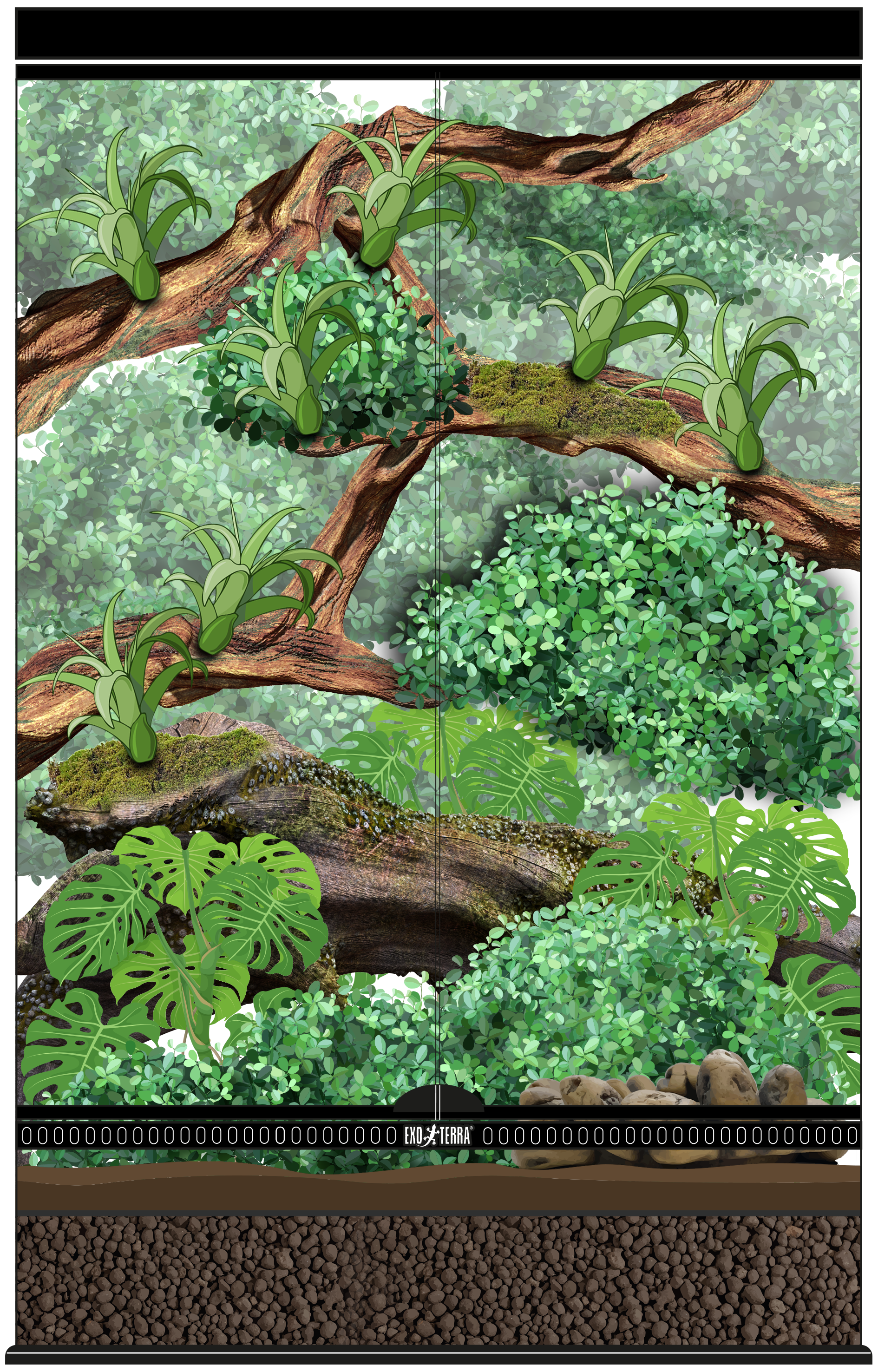
Rainforest Canopy Terrarium
The Rainforest Canopy Terrarium landscape replicates the upper layer of the equatorial rainforest with an abundance of branches covered with leaves and epiphytic plants like orchids, bromeliads, aroids (Pothos, Philodendron, Monstera, etc.), air plants (Tillandsia spp.), lichens, mosses and ferns. The Rainforest Canopy Terrarium landscape mimics the microhabitat of frogs living in a tree environment where only smaller water bodies occur, with no pond, stream or river in the immediate vicinity. This terrarium landscape utilizes a water dish (such as the Frog Pond) for hydration and egg deposition. The Rainforest Canopy Terrarium habitat can best be replicated in vertically oriented terrariums.
Rainforest Canopy Paludarium
The Rainforest Canopy Paludarium landscape replicates the upper layer of the equatorial rainforest with an abundance of branches covered with leaves and epiphytic plants like orchids, bromeliads, aroids (Pothos, Philodendron, Mostera, etc.), air plants (Tillandsia spp.), lichens, mosses and ferns. The Rainforest Canopy Paludarium landscape mimics the semi-aquatic habitat of frogs living in the tree environment of the riparian zone, with branches and leaves positioned over the water of a pond, stream or river. This terrarium landscape utilizes the bottom part of the terrarium partially as water body for hydration and egg deposition. The Rainforest Canopy Paludarium habitat can best be replicated in vertically oriented terrariums.
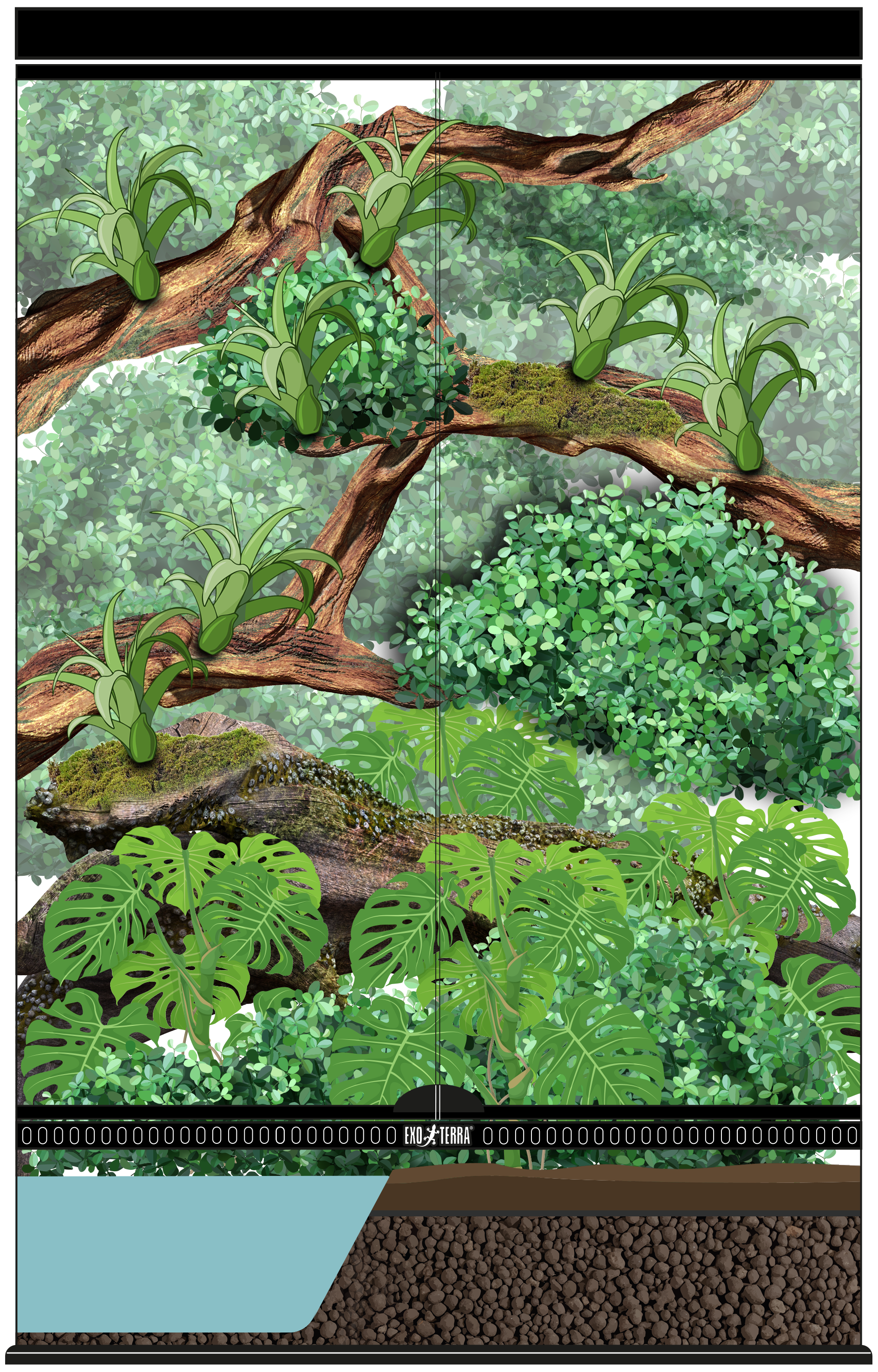

Rain Chamber Paludarium
The Rain-chamber Paludarium landscape replicates the semi-aquatic environment of a tropical forest during heavy rainfall. The rain-chamber paludarium can be used as a permanent habitat for aquatic, semi-aquatic or tree frogs, but the main purpose is to induce breeding in frog species that live in the riparian zone or come to the riparian zone during the mating season. Since the landscaping of this terrarium is reduced to the bare minimum, most hobbyists prefer to use the rain-chamber paludarium only for breeding purposes and keep their frogs in a nice bioactive set-up for the rest of the year. The rain-chamber paludarium landscape utilizes the complete bottom part of the terrarium as a water body for hydration and egg deposition. The landscaping consists of diagonally placed branches and cork pieces reaching to the top of the terrarium and some sturdy aroid plants like Pothos, Philodendron, Monstera, etc. and some bromeliads.
The set-up can be a simple “rain chamber-type” terrarium with a 2-6 inches (5-15cm) water part and some branches or a more natural bio-active type set-up with a separate land and water part mimicking a lakeshore or riverbank, by using the Bio Drain system. In both set-ups you will need to provide ample climbing space by strategically placing branches, cork pieces and vines in the terrarium. By arranging these perches diagonally, the frogs will be able to thermoregulate, choose the amount of UVB they want to absorb, etc. With a combination of sturdy artificial and live plants, you can provide the much-needed foliage which will allow the frogs to rest and hide in shaded areas of the Terrarium.
DISCLAIMER In regard to the pet species and number of specimens to be kept in a terrarium, always comply with the species specific Rules and Regulations in your Country of residence.
DISCLAIMER The terrarium should be placed in a room receiving only indirect light from windows. Do not place the Terrarium near a window where it can receive direct sunlight, as this could cause the terrarium to overheat and stress or kill your Red-Eyed Tree Frogs.

Rainforest Canopy Terrarium
The Rainforest Canopy Terrarium landscape replicates the upper layer of the equatorial rainforest with an abundance of branches covered with leaves and epiphytic plants like orchids, bromeliads, aroids (Pothos, Philodendron, Monstera, etc.), air plants (Tillandsia spp.), lichens, mosses and ferns. The Rainforest Canopy Terrarium landscape mimics the microhabitat of frogs living in a tree environment where only smaller water bodies occur, with no pond, stream or river in the immediate vicinity. This terrarium landscape utilizes a water dish (such as the Frog Pond) for hydration and egg deposition. The Rainforest Canopy Terrarium habitat can best be replicated in vertically oriented terrariums.

Rainforest Canopy Paludarium
The Rainforest Canopy Paludarium landscape replicates the upper layer of the equatorial rainforest with an abundance of branches covered with leaves and epiphytic plants like orchids, bromeliads, aroids (Pothos, Philodendron, Mostera, etc.), air plants (Tillandsia spp.), lichens, mosses and ferns. The Rainforest Canopy Paludarium landscape mimics the semi-aquatic habitat of frogs living in the tree environment of the riparian zone, with branches and leaves positioned over the water of a pond, stream or river. This terrarium landscape utilizes the bottom part of the terrarium partially as water body for hydration and egg deposition. The Rainforest Canopy Paludarium habitat can best be replicated in vertically oriented terrariums.

Rain Chamber Paludarium
The Rain-chamber Paludarium landscape replicates the semi-aquatic environment of a tropical forest during heavy rainfall. The rain-chamber paludarium can be used as a permanent habitat for aquatic, semi-aquatic or tree frogs, but the main purpose is to induce breeding in frog species that live in the riparian zone or come to the riparian zone during the mating season. Since the landscaping of this terrarium is reduced to the bare minimum, most hobbyists prefer to use the rain-chamber paludarium only for breeding purposes and keep their frogs in a nice bioactive set-up for the rest of the year. The rain-chamber paludarium landscape utilizes the complete bottom part of the terrarium as a water body for hydration and egg deposition. The landscaping consists of diagonally placed branches and cork pieces reaching to the top of the terrarium and some sturdy aroid plants like Pothos, Philodendron, Monstera, etc. and some bromeliads.
The set-up can be a simple “rain chamber-type” terrarium with a 2-6 inches (5-15cm) water part and some branches or a more natural bio-active type set-up with a separate land and water part mimicking a lakeshore or riverbank, by using the Bio Drain system. In both set-ups you will need to provide ample climbing space by strategically placing branches, cork pieces and vines in the terrarium. By arranging these perches diagonally, the frogs will be able to thermoregulate, choose the amount of UVB they want to absorb, etc. With a combination of sturdy artificial and live plants, you can provide the much-needed foliage which will allow the frogs to rest and hide in shaded areas of the Terrarium.
DISCLAIMER In regard to the pet species and number of specimens to be kept in a terrarium, always comply with the species specific Rules and Regulations in your Country of residence.
DISCLAIMER The terrarium should be placed in a room receiving only indirect light from windows. Do not place the Terrarium near a window where it can receive direct sunlight, as this could cause the terrarium to overheat and stress or kill your Red-Eyed Tree Frogs.
Lighting
Although American Green Tree Frogs are mainly crepuscular to nocturnal, they will sometimes be active during daytime. A 12-hour day/night cycle will benefit your frogs and stimulate live plant growth. The Exo Terra® TerraSky Planted Terrarium Light is ideal for planted setups, paludariums and bioactive terrariums. The high intensity and enhanced penetration ensure that the light reaches all layers of the terrarium, resulting in sustained lush plant growth. Orchids, Bromeliads, Tillandsias (air plants), carnivorous plants, mosses and lichen all thrive under the TerraSky Planted Terrarium Light’s strong Photosynthetic Active Radiation (PAR). The 120-degree light dispersion provides a nice even illumination and covers the complete area to avoid dark spots.
Providing UV-lighting is not absolutely necessary, but the correct amounts of UVB will help your frogs to metabolize calcium and prevent metabolic bone disease. The combination of the correct UVB wavelength and heat enables the animals to produce their own vitamin D3 for proper calcium absorption and prevents metabolic diseases (e.g., MBD). We highly recommend the use of our Reptile UVB100. The low levels of UVB-rays produced by these bulbs are very beneficial for the animal’s overall health, while the UVA rays stimulate appetite, activity and reproductive behavior.
Heating
American Green Tree Frogs thrive if provided with a daytime temperature gradient between 73-80°F or 23-27°C and a slight nighttime drop to 65-70°F or 18-21°C. To create a basking area (81°F/27°C) that enables your Frogs to thermoregulate their body temperature, an Exo Terra® Light Dome or Reptile Dome with Light Bracket and a Daylight Basking Spot, Halogen Basking Spot or Swamp Basking Spot will provide them with a perfect temperature gradient. The Night Heat Lamp can be used for 24-hour heating if it’s used in combination with a light emitting bulb during the day. Refer to the charts in the Lighting section to select the right bulb wattage.
The water temperature in the Paludarium section should be kept at around 78°F or 25°C. Exo Terra® Turtle Heaters are convenient to use as they are preset to 78-79°F or 25-26°C.
An Exo Terra® Heat Mat can also be used if applied to one side of the terrarium, creating a temperature gradient. Do not apply the Heat Mat under the terrarium, as this will dry out the substrate rather quickly.
Use 2 Digital or Analog Exo Terra® Terrarium Thermometers, place one in the warm and one in the cooler side of the Terrarium, this allows you to keep a keen eye on matching the preferred temperature gradients. The Heat Lamp or Heat Mat wattage may need to be adjusted depending on the ambient room temperature and the terrarium type used. To ensure the perfect ambient temperature for your Frogs, an Exo Terra® Thermostat can be used (see Monitoring section).
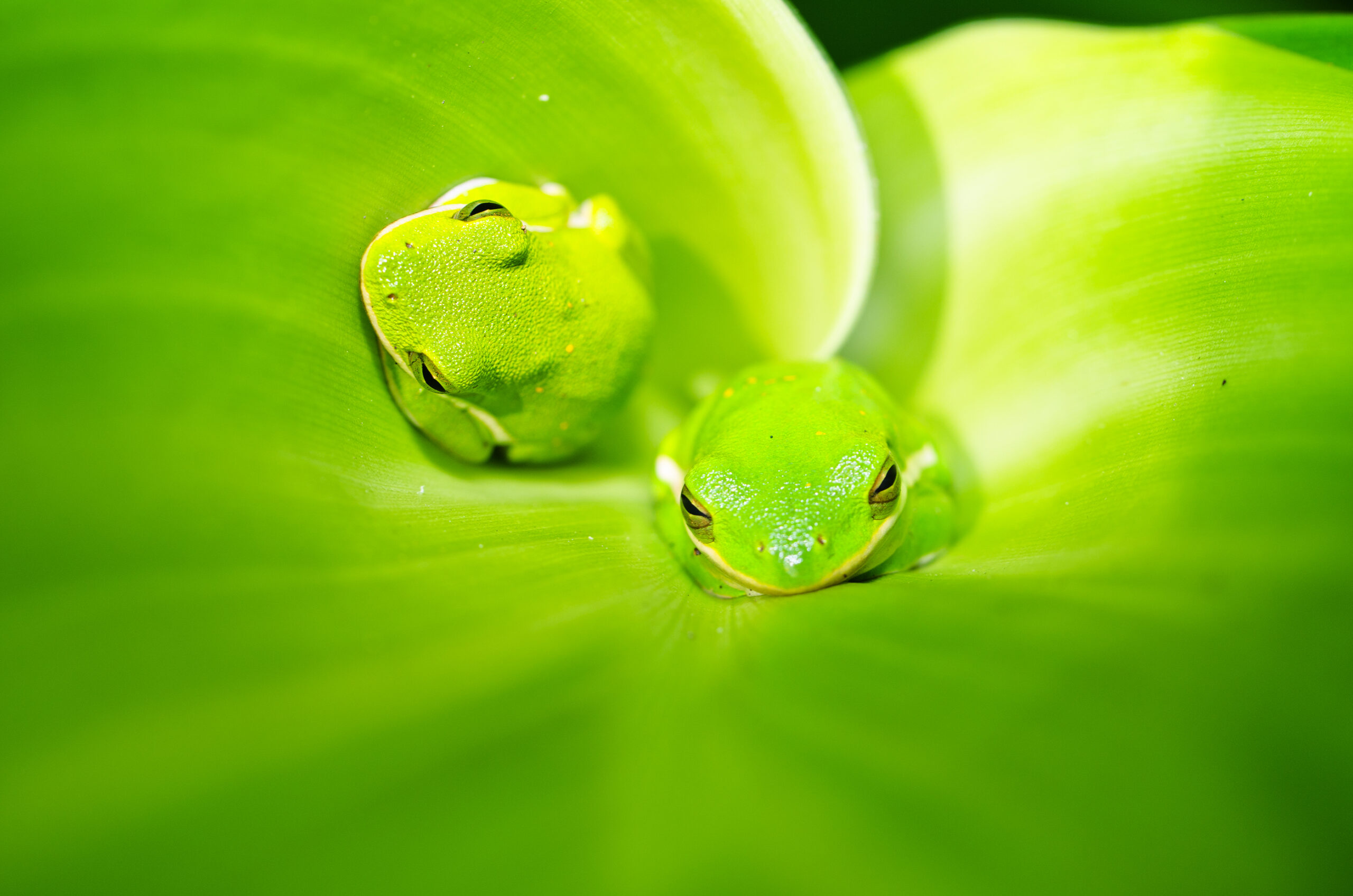
Two Hyla cinerea specimens sleeping inside a folded leaf – by Kan Li.
Monitoring
For more security and peace of mind, the Exo Terra® Thermostats or Thermostat & Hygrostat will help to prevent overheating and undercooling during hot summer days or cold winter nights. Apart from the temperature, the Exo Terra® Thermostat & Hygrostat will also keep the humidity at the desired level, if used in combination with an Exo Terra® Humidifier or Fogger. With the Exo Terra® Thermostats or Thermostat & Hygrostat, you can create a well-controlled heating/humidifying system that allows you to maintain the required temperature and/or humidity conditions similar to those found in your animal’s environment.
Substrate
American Green Tree Frogs thrive well in a paludarium setup. The Paludarium’s living space consists of 3 distinct zones:
Terrestrial Zone The terrestrial zone is a land area with plants, trees, bushes and rocks that never submerge. In tropical climates, a variety of invertebrates, reptiles and amphibians occur here.
Riparian Zone The riparian zone or riverbank is the interface between land and water. It is inhabited by semi-aquatic reptiles and amphibians.
Aquatic Zone The aquatic zone can be a stream, pond or even lake – home to turtles, aquatic amphibians, fishes and freshwater shrimps.
To create the Terrestrial and Riparian Zone, you can use Bio Drain Substrate with a Bio Drain Mesh, topped with Exo Terra® Sub Stratum and/or Plantation Soil, covered with leaf litter and/or moss (Exo Terra® Equatorial Forest Floor or Forest Moss). The non-toxic Bio Drain mesh will keep the underlying Bio Drain Draining Substrate separated from the decorative top-layer substrate. It will prevent substrate particles from contaminating the water while still allowing proper water drainage. In combination with the Bio Drain Substrate, you can create water parts and a biological filtration system in the terrarium. The clean terrarium water can then be circulated in Waterfalls, Cascades or Dripping Plants. In the Terrestrial Zone, you can build your decorative layer with plants, branches, lianas, rocks, hides, etc. The actual substrate layer that will be used for planting can consist of a mixture of Exo Terra® Sub Stratum with Exo Terra® Plantation Soil. The Riparian Zone remains somewhat open, with some smaller pebbles, or flat wood or stone pieces that allow easy access to the Aquatic Zone. For the Aquatic Zone, Turtle Pebbles are a great choice as their dimensions are big enough to avoid being swallowed by the frogs, but offer a stable substrate and are easy to clean.
The Exo Terra® Sub Stratum is a natural volcanic soil with live beneficial bacteria. The porous surface and low-density structure allow for excellent drainage and aeration, but it also promotes a flourishing population of beneficial, nitrifying bacteria, creating a self-sustaining, living terrarium ecosystem. The active beneficial bacteria of the soil will decompose biological waste, keeping the terrarium clean and healthy. By mixing the Sub Stratum with other organic substrates, you enrich any substrate with the required minerals like calcium, nitrogen, potassium and phosphorus. It also aids in the water retention capacity and provides adequate air supply to the roots.
The Exo Terra® Equatorial Forest Floor is a multi-layer substrate that allows you to recreate the forest floor as found in natural equatorial forests. The Equatorial Forest Floor provides a base layer and a top layer. The base layer consists of a rich organic matter from ground coconut husk fiber. It is a 100% natural, ecological, and biodegradable substrate with great hygroscopic properties. The top layer consists of sun dried decorative Ardisia leaves from a sustainable resource. The top layer covers the actual substrate underneath to facilitate its moisture retention and prevent the soil from drying out.
The Exo Terra® Forest Moss is real compressed moss grown in tropical Asia and does not contain any dyes or chemicals. This ecological substrate is extremely absorbent and ideal for increasing humidity in the terrarium. It is totally safe for use with frogs, salamanders and burrowing or digging animals.
The Exo Terra® Plantation Soil is a 100% natural, biodegradable terrarium substrate made from sustainable, ground coconut husk fiber grown on plantations in tropical Asia. The unique hygroscopic properties of this ecological substrate regulate the terrarium’s humidity in a natural way and is totally safe for frogs, salamanders and other burrowing or digging animals. The unique coir pith used for the Exo Terra® Plantation Soil consists of a mixture of short fibers and coco-peat grain sizes ranging from coarse granules to fine clumps resulting in improved soil drainage and aeration. The improved aeration of the substrate promotes the cultivation of healthy waste-reducing organisms keeping your terrarium fresh and clean.
The substrate should be kept moist, but not soaking wet, at all times. Make sure to offer different gradients of moisture inside the terrarium. Some parts can be kept rather moist while other parts should be kept somewhat drier. Also, try to vary the moisture depending on the season, spray more frequently during the warmer parts of the year.
The Exo Terra® substrates will help maintain the substrate moisture at an optimal level. Providing a top layer of Exo Terra® Equatorial Forest Floor or Forest Moss will also facilitate the substrate’s moisture retention and prevent it from drying out. The ardisia leaves or forest moss also provide hiding spots for the reptiles and amphibians foraging the forest floor and at the same time, facilitate the natural ecosystem where beneficial organisms will break down waste products and thus reduce odors.
The secret to growing healthy plants begins with the soil. Naturally, healthy soil contains living microorganisms — from bacteria to fungi, protozoa and arthropods. Together, they form a choreographed exchange from the recycling of nutrients to the decomposition of organic materials.
Plants
The land part of the terrarium can partially be decorated with live and/or Exo Terra® artificial or smart plants. Live plants and moss will contribute to the filtration capacities of your terrarium. This type of setup allows you to create an effective filtration system, mirroring the process of natural biological filtration. A fully functioning aqua-terrarium or paludarium will provide a constant source of clean water, which is imperative to keep semi-aquatic species. It is basically a small, closed ecosystem.
Ideal for Tree Frogs are all the vining plants like Philodendron, Epipremnum (pothos) and Scindapsus, etc. but also other sturdy large-leaved plants like Aglaonema, Dieffenbachia, Monstera are well accepted as sleeping and hiding places.
Many hobbyists choose to introduce live plants in pots that are buried in the substrate and concealed with decor items, like cork bark or rocks. The Exo Terra® Snake Bowl can be used as a decorative planting pot. Its extra deep design makes it suitable for small to medium live terrarium plants.
DISCLAIMER Make sure the plants have no pests before introduction and rinse leaves thoroughly to remove any pesticide residues.
Exo Terra® offers a wide range of artificial plants with the same advantages as live plants; they’re decorative, they provide shade, and they create hiding spots and visual barriers to let your reptiles and amphibians experience an increased feeling of safety and reduced stress. Exo Terra’s artificial plants are exact copies of their natural counterparts to blend in well with live plants but are much easier to maintain. A combination of live plants and Exo Terra’s artificial plants allows you to fully plant a terrarium, even in the hottest or driest parts.
Exo Terra®’s Bromeliad’s, Scindapsus, Philodendron and hanging Plants are easy to clean & maintain, while the weighted base of the Bromeliad’s, Scindapsus, Philodendron allows you to easily position the plant after maintenance.
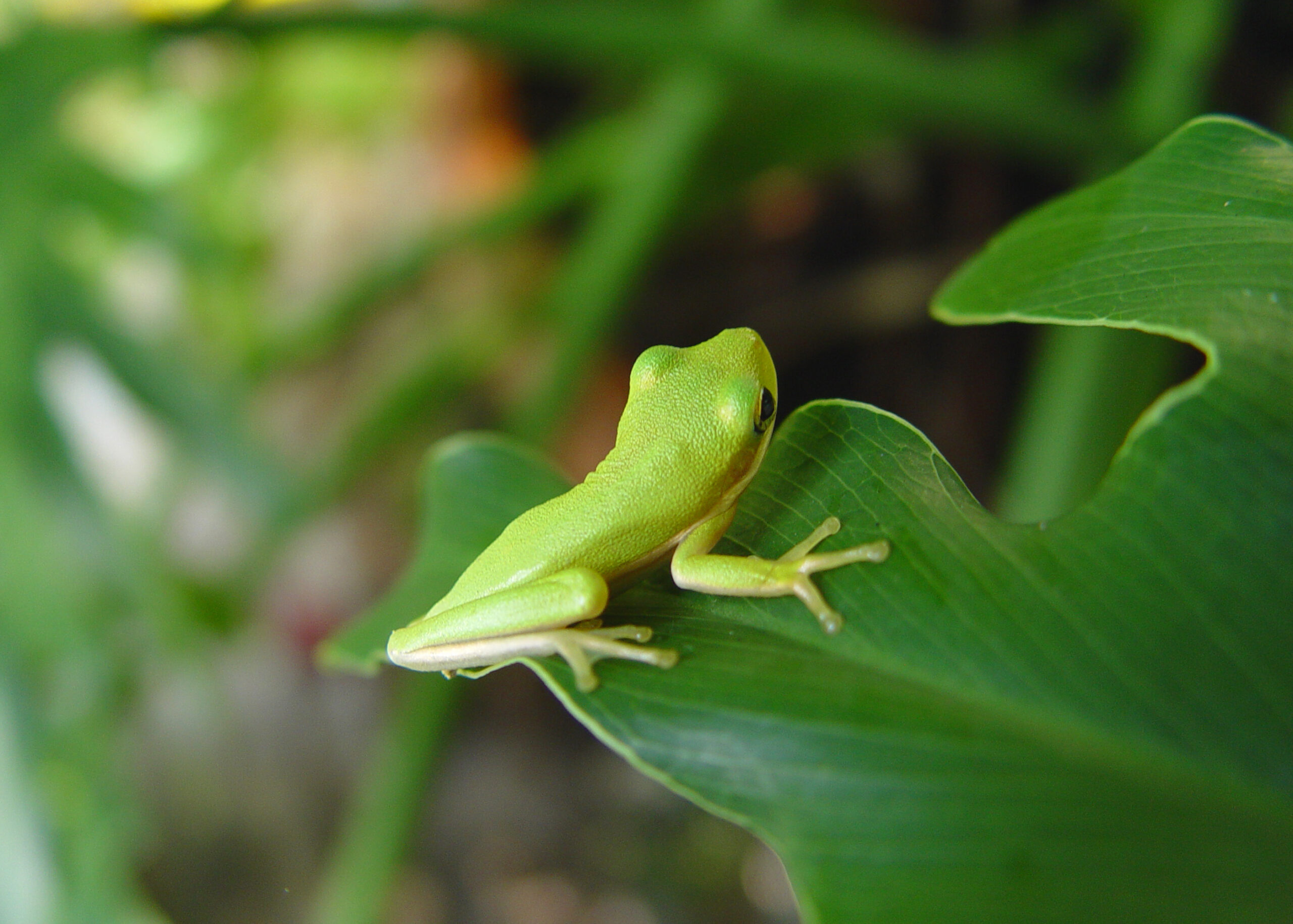
Juvenile Hyla cinerea on leaf – by E. Mendel.
Hide-outs
Exo Terra®’s Bromelia’s, Scindapsus, Philodendron and hanging Plants will help to provide visual barriers.
An additional decorative hide like the Exo Terra® Canopy Cave will add even more privacy to your frog’s habitat.
Decor
Landscaping a terrarium will not only encourage the frog’s activity and exploratory behavior, but also provide extra cover which increases the frog’s sense of security and reduces its stress levels.
The land part of the terrarium can partially be decorated with live and/or Exo Terra® artificial or smart plants. Various branches can be used to create climbing space. Adding Exo Terra® Vines is a great way to create more climbing space. These waterproof vines are bendable, twistable life-like vines with a natural feel and look and can be twisted together with vines of different sizes to create a 3-D habitat. The Exo Terra® Jungle Vines and Moss Vines can be combined to enhance the natural Rainforest-look of your Terrarium.
Waterfalls and Cascades add aesthetic appeal and will help oxygenate and biologically filter the water.
The Exo Terra® Frog Pond and Coconut Water Dish have a realistic design and will enhance the naturalistic flair of the habitat’s design.
Exo Terra® offers a wide variety of innovative decor items like Skulls, Waterfalls, Ground Cover Plants, etc. – all of which add next to personalizing accents, some more environment enrichment and features.
Diet
American Green Tree Frogs are insectivorous and should be fed with a variety of live, canned or vacuum-packed insects of appropriate size. As a general rule, the maximum size of the insects should be the width of the frog’s head. Offer as much variety of insects, in your American Green Tree Frog’s diet, as possible, to make sure that your frog receives all possible essential nutrients. All live insects should be gut-loaded with nutritious foods, like apple slices, sweet potato, oranges, cereals, bee pollen, etc., 24-48 hours prior to being fed to your frog.
Because commercially raised insects tend to be deficient in calcium and several vitamins, they must be supplemented by coating with a reptile vitamin and mineral supplement such as Exo Terra® Multi Vitamin blended with an equal part Calcium. Always dust your feeder insects with a 1:1 mix of Exo Terra® Multi Vitamin and Calcium + D3 powder supplement using the “shake & bake” method of coating insects.
Exo Terra® Canned or Vacuum-Packed insects can be fed right out of the can/pouch as these insects are well fed and vitamin-calcium coated.
Exo Terra® offers 11 varieties of Canned and Vacuum-Packed Foods which allow you to bring more variety in your American Green Tree Frog’s diet. American Green Tree Frogs will readily accept canned or vacuum-packed foods if you use tweezers to make the insects appear to be alive. Just hold the insect in front of the frog and slowly wiggle it so it appears to be moving. Loosen the tweezers as soon as the frog grabs the insect. The Exo Terra® Canned and Vacuum-Packed Specialty Reptile Foods are a convenient way to feed insect eating reptiles, turtles, amphibians, fish and birds. These insects (and snails) have been cooked in the can to maintain nutritional value, flavor and aroma. The retorting process also softens the exoskeleton of the insects for easier digestion and breaks the bonds between the collagen protein to make it absorbable by reptiles. Collagen is an important fiber that aids in building bone, cartilage, skin and claw structures. Canned and Vacuum-Packed insects have the same nutritional value as live insects but are easier to digest. Visit our Canned and Vacuum-Packed Foods webpage for more information.
Feed juveniles daily and adults every second or third day.
Hydration
The presence of clean and fresh water is important for the proper care and maintenance of captive reptiles and amphibians.
Because American Green Tree Frogs may bathe and soak up water via their skin, but also because they lay their eggs in water, you should always offer fresh and clean water. Always treat tap water with Aquatize to remove harmful heavy metals, chlorine and chloramines, necessary to provide safe healthy water for your captive reptiles and amphibians. In a bio-active set-up, you can use Exo Terra® Turtle Clean (PT1998) to add beneficial organisms to the terrarium water and speed up the biological filtration capabilities. Liquid Electrolyte and Calcium can be added to the water to support healthy bone and muscle growth in your frogs and especially tadpoles.
An ideal Water Dish for use with amphibians is the Exo Terra® Frog Pond. The Exo Terra® Frog Pond has a very natural and realistic pebble-rock finish that integrates in any type of terrarium. The Frog Pond’s unique shape allows you to install the pond semi-recessed in the substrate to mimic a riparian zone. This design offers easy access for reptiles and amphibians to hydrate while the shallow water body and integrated steps prevent the animals from drowning.
The average humidity should be kept between 50-60% with peaks of 70-75% in the morning and evening (when the terrarium is sprayed/misted), similar to what these frogs experience in nature. The Exo Terra® Monsoon is a handy device to guarantee that your frog terrarium is sprayed at a set time every day. The Exo Terra® Humidifier can help maintain the correct relative humidity in the terrarium, especially if used in combination with the Exo Terra® Thermostat & Hygrostat. Make sure the Terrarium is well ventilated and the humidity is not kept permanently high as American Green Tree Frogs are prone to bacterial skin infections.
Maintenance
Land area;
Spot-clean your American Green Tree Frog’s enclosure once a week or more if necessary; remove fresh or dried faeces, dead insects, etc. For a more thorough cleaning, remove all the decor pieces and clean these with warm water. Always keep a keen eye on the substrate; as long as the substrate is not degrading or does not have a foul odor, the spot cleaning process is sufficient. Once the substrate starts to degrade or spreads a foul odor, it needs to be replaced completely.
Water part;
When using a water circulation pump or filter, it is best to clean the water inlet and filter media every 2-3 weeks to ensure optimal performance. Water changes should be performed on a bi-weekly basis; remove about ¼ to ⅓ of the water and replace it with fresh water of the appropriate temperature. Partial water changes can help to remove toxic substances or improve the overall water quality. Unless really necessary, make sure to never perform entire water changes, as this will also remove beneficial bacteria and organisms. Always treat tap water with Aquatize to remove harmful heavy metals, chlorine and chloramines when performing water changes. Use Turtle Clean (PT 1998) to assure that the beneficial organisms in the terrarium water remain at an ideal level to keep the biological filtration system performing well.
Breeding
In the wild, American Green Tree Frogs breed from April through August, mostly after heavy summer rains. Most American Green Tree Frog breed once per year, but some have been recorded to produce multiple clutches in a single mating season. In order to simulate these conditions, you first have to reduce the light cycle from 12 to 8 hours daily and keep the temperature at 65°F or 18°C for about 5-6 weeks. Keep the humidity at the lower end (50%) by spraying less, simulating a drier, cooler winter period. Allow the water temperature in the Paludarium section to drop to 65-70°F or 18-21°C. Feed the frogs only sparingly during this brumation period. After this 5-6 weeks brumation period, the light cycle should be increased to 12-14 hours daily and the temperatures restored to the normal settings (73-80°F or 23-27°C). At this point, the water temperature in the Paludarium section should also be restored to its normal 78°F or 25°C. Exo Terra® Turtle Heaters are convenient to use as they are preset to 78-79°F or 25-26°C.
The spray intervals should be increased to simulate the rainy season, and average humidity can be kept at 70-80%. After the pairings have been completed, and the eggs have been laid, the average humidity can be reduced to the normal 50-60% again. The frogs will become more active and start feeding a bit more than average. After a week, proceed with spraying/misting the terrarium extensively to simulate the summer rains. In reaction to the simulated summer rains, the males will start their mating call to attract females and grasp them behind the front arms to hold them in an amplexus.
A male surplus of 2 males for 1 female will definitely encourage healthy competition between the male specimens in the terrarium, resulting in successful matings and best breeding results.
The female frogs will deposit between 400-700 eggs (in clutches of 200-300 eggs at a time) that adhere to all kinds of floating and submerged objects, like plants, rocks, branches and driftwood, etc. The tadpoles will hatch after 4-5 days but will remain motionless and not feeding for another 2-3 days.
After the pairings have been completed and the eggs have been laid, the average humidity can be reduced to the normal 50-60% again.
Once the tadpoles start swimming, they will also start feeding on frog & tadpole food, dead insects, chopped earthworms, fish food flakes, algae, plants, etc. It takes the tadpoles approximately 6-8 weeks to fully metamorphose into air-breathing amphibians. In this stage, it is critical to provide the metamorphosing tadpoles with sufficient plants, branches or a smooth levelled riverbank so they have easy access to the land area.
The newly-emerged frogs will absorb the remnants of their tail for the next few days and will then start feeding on food items of appropriate size like fruit flies, freshly hatched crickets, bloodworm, hatchling waxworms, flour moth larvae, etc. As with adults, always dust the feeder insects with a 1:1 mix of Exo Terra Multivitamin and Calcium +D3 powder supplement. The freshly metamorphosed frogs can be raised under similar conditions as used for the adult frogs, just make sure the water isn’t too deep, and there are slopes available so the frogs can easily climb onto land areas.
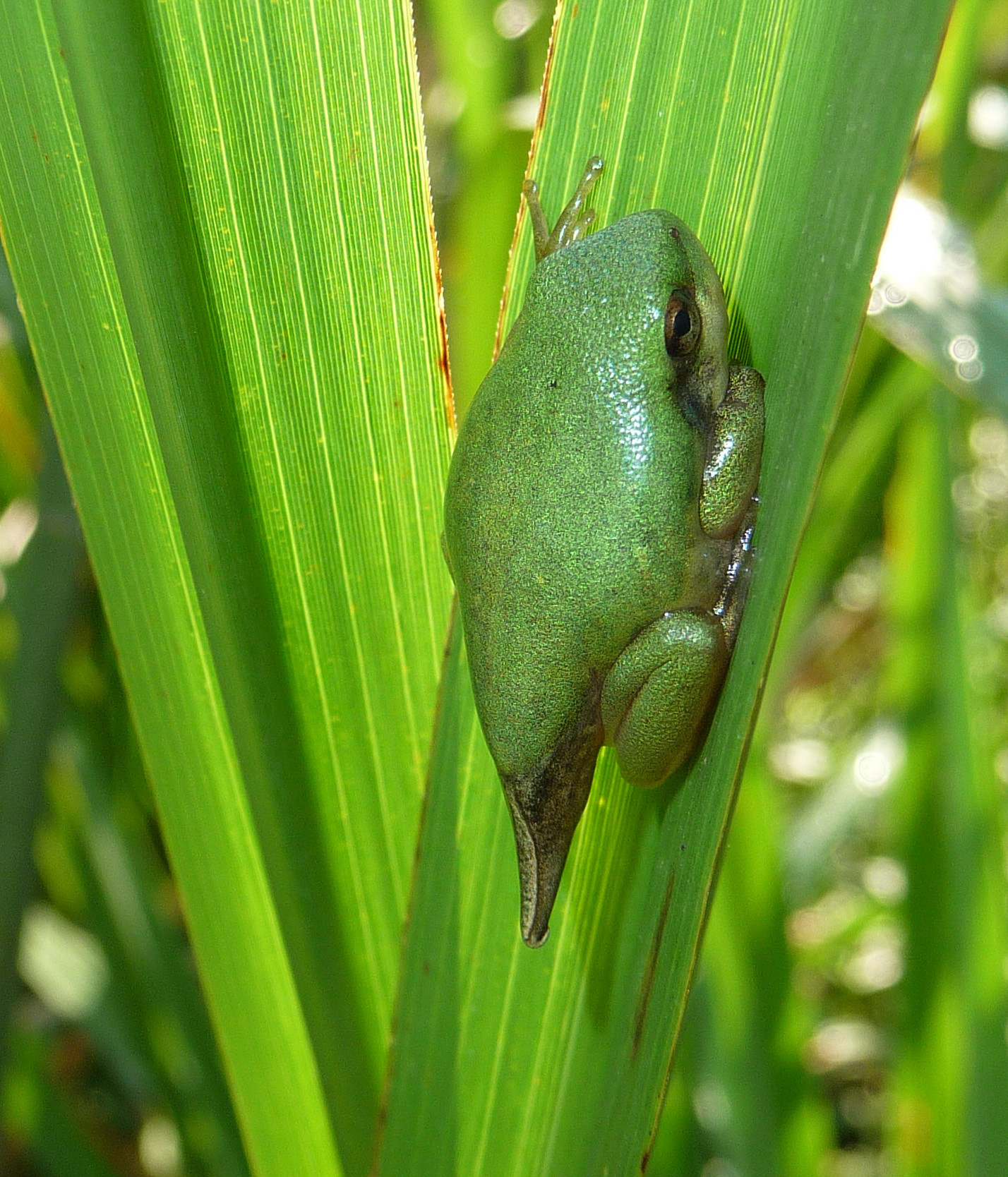
Hatchling Hyla cinerea in the final stage of metamorphosis– by W. Parker.
Handling
Every amphibian’s skin contains very mildly toxic substances that can irritate eyes or open wounds so always thoroughly wash and rinse your hands with warm water before and after handling any amphibian. If you accidentally touch your eyes while handling an amphibian, you might experience a somewhat burning sensation. Should this happen, make sure to rinse your eyes immediately and thoroughly with water, that should relief the burning sensation immediately.
DISCLAIMER Always make sure to thoroughly wash and rinse your hands with warm water before and after handling any reptile, amphibian or invertebrate.
Conclusion
Did you know?
Although the American Green Tree Frogs are mainly arboreal, they still prefer to live very close to waterbodies, especially near ponds, lakes, streams and wetlands, which are home to lots of floating plants (such as water lilies and duckweed), grasses, or reeds.
American Green Tree Frogs are sometimes called “bell frogs” due to their obtrusive mating call. The males perform a mating call, that sounds like an old horn honking up to 75 times a minute, to attract the females.
The mating call of the American Green Tree Frog is very distinct from their common croaking and can be heard by females over a long distance.
Although American Green Tree Frogs are generally green, they can still adapt their color from green to olive green or even brownish depending on their mood.
Some individuals show yellow or golden spots on top of the green color on their backs.
American Green Tree Frogs use nuptial pads to tighten their grip during the amplexus (mating). These pads not only serve to improve the male’s grip on the female during amplexus, but glands below the surface of the nuptial pads also secrete pheromones (amplexins) that may influence the courtship duration.
Tips
The Exo Terra® Cricket Pen is ideal for housing, keeping and dispensing live crickets. To keep your crickets alive longer “gut load” or provide a slice of apple for food!
Misting can be automated with the Exo Terra® Monsoon, a programmable misting system suitable for all types of terrariums. It helps maintain optimal humidity by generating a fine mist at programmed intervals, the duration and frequency of which can be easily adjusted.
The Exo Terra® Humidifier can help maintain the correct relative humidity in the terrarium, especially if used in combination with the Exo Terra® Thermostat & Hygrostat.
Use the Exo Terra® Terrarium Cleaner & Deodorizer to clean water dishes and decor items. It removes organic stains and odours, without any risk to your frog.
Stubborn calcium deposits from misting can be easily removed using the Exo Terra® Terrarium Glass Cleaner. The Glass Cleaner’s non-toxic gel formula easily removes calcium and lime stains from the terrarium glass.
Proving sufficient well-balanced light, by using the Exo Terra® TerraSky in combination with a mild UVB bulb like the Exo Terra® Reptile UVB100, will assure proper plant and moss growth, contribute to your amphibian’s physiological well-being and stimulate mating behavior. The dim moonlight, provided by Exo Terra’s TerraSky, Full Moon or Day & Night LED allows you to observe your American Green Tree Frogs at night. These fixtures also provide sufficient light for crepuscular and nocturnal animals to navigate the terrarium in search of insects, mating-partners, etc… In total darkness American Green Tree Frogs would be disoriented.
Are American Green Tree Frogs the right choice for me?
American Green Tree Frogs are hardy, long-lived and “easy-to-care-for” amphibians. Their engaging personalities, their bright yellow-green back and cream-white lateral stripe running from just under their big golden eyes all the way to their groin, make them appealing display animals for both the beginning reptile enthusiast as well as for the advanced hobbyist.
Should I feed a variety of food items to my American Green Tree Frogs or can I stick to just 1 type feeder insect?
Bring as much as possible variation in your American Green Tree Frog’s diet to make sure that your frog receives all possible essential nutrients. With Exo Terra’s Canned or Vacuum-Packed insects, it’s easy to offer a wide variety to make sure that your frogs receive all the nutrients they need. The Canned and Vacuum-Packed insects have the same nutritional value as live insects but are easier to digest.
Are American Green Tree Frogs poisonous?
Can I feed my American Green Tree Frogs wild caught insects?
We do not recommend feeding wild caught insects as these can harbour harmful bacteria. They may also have come in contact with gardening chemicals, making them poisonous for your Frogs.
Can I keep other amphibians and reptiles together with my American Green Tree Frogs?
American Green Tree Frogs are best kept in a small group of their own kind. Other species, especially diurnal animals, could disturb the frog’s sleep.

